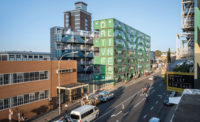“They’re a bit rock ’n’ roll,” says Ada Tolla when asked to describe her clients for a recently completed house. Tolla, together with partner Giuseppe Lignano of LOT-EK—the New York–and Naples-based firm known for building with disused industrial objects—designed an eye-catching structure made entirely of shipping containers that has attracted lots of attention in its residential neighborhood in Brooklyn.
The containers aren’t new for LOT-EK; what is new is the form. By slicing the tops of the containers diagonally across the length of the corner lot, LOT-EK created an assembly that not only cuts a striking figure, but also reinvents the New York townhouse typology. “Thanks to the accident of the incline, there is a terrace at each level instead of just one outdoor space behind the house,” says Tolla.
The diagonal is mimicked on the underside of the structure’s front to serve as the main entrance, and what originally was intended as a driveway. That has temporarily been moved to the back, where a pool was planned, until the city grants permission for a curb cut at the front of the site.
Building something this unconventional produced a number of obstacles, not just from the local building department, but also from the bank. “If we were doing a regular brownstone, it would have been easy enough, but getting a construction loan for this was incredibly difficult, because there were no comparables,” recalls Joe Carroll, a restaurateur who shares the house with his wife and young children. “Of course there are no comps!”
So while the project was much delayed because of permitting and financing issues, the actual installation of the containers—which were delivered to the site on trucks and lifted into place over a poured concrete basement by a giant crane—took only four days. For earlier commercial and cultural buildings that LOT-EK designed with shipping containers, the architects worked with Silman engineers, who’ve since become experts at this type of construction. In this house, they provided extra structure in the form of columns composed of back-to-back steel “C” channels, as well as diagonal bracing at the front cantilever.
The containers used here, known as “high cubes,” are 40 feet long by 8 feet wide by 91⁄2 feet high. The house is three containers wide; their former doors, at the short end, make up the front facade. The corrugated side forms the long exterior wall, a rhythmic composition punctuated by vertical slit windows, mostly inoperable, and touches of color where portions of the containers’ original exteriors are exposed. The rest of the structure is painted brown.
The brown color palette is carried over to the interiors, where the original container decking, in apitong wood, was sanded and adapted for the floors. The ceiling too is surfaced in a similar-toned luan plywood. “The clients wanted as little sheetrock as possible,” says Tolla. Basic industrial hardware, including continuous piano hinges on doors, is used throughout.
The inner corrugated walls of the containers separate rooms, or are cut away to free up the plan. The first floor containing the public spaces is particularly open, with clear views from front to back, where large sliding glass doors lead from the chef’s kitchen to an outdoor dining area. Carroll, who, not surprisingly, loves to cook and entertain, insisted on a large fireplace in the living room, which he plans to use as a pit for roasting meat.
As far as living in such an unusual setting goes, Carroll couldn’t be happier. “It really is a wonderful space to be in, because it doesn’t look the same as everything else,” he says. “It changes your perspective on living, since the visual cues are so different.”










Post a comment to this article
Report Abusive Comment